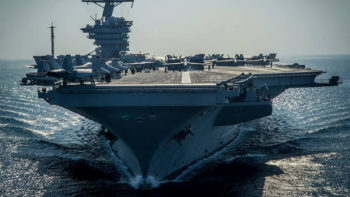
The flight deck of the USS Carl Vinson shakes as a succession of F-18 fighter jets are catapulted into take-off, emitting a thunderous noise and leaving white mist in their wake.
Crewmen aboard the aircraft carrier scramble to prepare for the next arrival in a frenetic cycle of take-offs and landings involving dozens of aircraft, a dramatic display of American power in the hotly contested South China Sea.
The USS Carl Vinson led a carrier strike group on Friday in waters some 400 nautical miles east of China’s Hainan Island and northeast of the Paracels, the island chain occupied by Beijing since it seized control from Vietnam in the 1970s.
China claims most of the South China Sea through which about $5 trillion in ship-borne trade passes every year. Neighbours Brunei, Malaysia, the Philippines, Taiwan and Vietnam also have claims.
China’s growing military presence in the waters has fuelled concern in the West, with the United States criticising its militarisation of maritime outposts and holding regular air and naval patrols to ensure freedom of navigation.
Tension between the United States and China over trade and territory under U.S. President Donald Trump has been stepped up of late, with fear in the region that the South China Sea, vital to global trade, could become a battleground between the two rival powers.
Some 30 fighter jets, helicopters and other aircraft took to the sky on Friday and crew in colour-coded uniform raced to service them, check their instruments and fit weapons. An overpowering smell of aircraft fuel lingered in the air.
At any given time, between eight and 25 aircraft are in the air, day and night, with 15-20 on standby.
USS Carl Vinson has been on patrol since Feb. 19 in the South China Sea, amid some confusion about U.S. staying power in the region under a Trump administration with policies skewed heavily towards a domestic agenda.
Comments so far by Washington have caused alarm, most notably those by Secretary of State Rex Tillerson, who suggested during his Senate hearing that China be blocked from accessing the islands it has built and fortified with surface-to-air missiles.
Rear Admiral James Kilby, the strike group commander, said the patrol was not a show of power, but a demonstration of U.S. commitment to the Asia-Pacific.
“We wanted to reassure our friends and allies and our belief in the freedom of navigation and security operations that we always conducted,” he reporters flown out to the carrier on Friday.
“We have operated in the past, and we will continue to operate in the future. We continued to demonstrate that the international waters are waters where everyone can sail.”
TESTING THE WATERS
Under former President Barack Obama’s pivot to Asia, Washington sought to challenge China’s growing assertiveness through FONOPS, or Freedom of Navigation Operations, which routinely riled Beijing, particularly those close to its seven artificial islands.
Some critics say the FONOPS have been both provocative and fruitless, having failed to deter China from building up what it considers legitimate defences.
A top Chinese official last year warned that FONOPS could “end in disaster”.
Friday’s exercise was far from the disputed areas of the waterway, rich fishing grounds which contain largely unexplored oil and gas deposits. Kilby there were “contacts” with merchant, fishing and military vessels in the past two weeks, though no “incidents”. He did not elaborate.
China has been guarded in its response to the latest U.S. mission, which started one day after Beijing finished its own aircraft carrier exercises.
It said it respected freedom of navigation and hoped the United States could “contribute positive energy towards this good situation”.
The crew aboard Carl Vinson will spend five months in Asia.
During Friday’s drills, one fighter missed its landing, or “recovery”, and was made to repeat the exercise, circling the vast ship before making a perfect landing.
Captain Douglas Verissimo, the skipper of Vinson, said the exercises included rigorous checks. Aircraft were simulating combat and bombing runs, performing over and over until flaws were ironed out.
“Every time they land, there’s someone grading them,” he said.